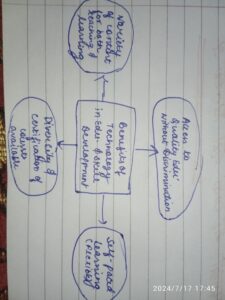What measures can be taken to address the learning gaps highlighted in ASER 2023, especially in the wake of the COVID-19 pandemic’s impact on education?
Integrating technology in schools to enhance learning while avoiding the widening of the digital divide requires a thoughtful and inclusive approach. Here are several strategies to achieve this balance: *Digital Literacy Programs - Basic Skills Training: Provide training for students and parents onRead more
Integrating technology in schools to enhance learning while avoiding the widening of the digital divide requires a thoughtful and inclusive approach. Here are several strategies to achieve this balance:
*Digital Literacy Programs
– Basic Skills Training: Provide training for students and parents on basic digital skills and internet safety.
– Curriculum Integration: Integrate digital literacy into the regular curriculum so that students learn these skills alongside traditional subjects.
– Parent Workshops: Offer workshops and resources for parents to help them support their children’s use of technology for learning.
*Resource Allocation
– Prioritize Funding: Allocate funds specifically for technology integration and support for low-income students.
– Grant Applications: Apply for grants and funding from government programs and private organizations aimed at reducing the digital divide.
– Budget Transparency: Ensure transparency in how funds are used to support technology integration and address inequities.
*Monitoring and Assessment
– Data Collection: Regularly collect data on technology usage and access among students to identify gaps and address them promptly.
– Feedback Mechanisms: Create channels for students, parents, and teachers to provide feedback on technology use and access issues.
– Continuous Improvement: Use the data and feedback to continuously improve technology integration strategies and ensure they are meeting the needs of all students.
* Community and Parental Engagement
– Information Sessions: Hold information sessions to explain the benefits and uses of technology in education and how it can support student learning.
– Collaborative Efforts: Engage parents and community members in planning and decision-making processes related to technology integration.
– Support Networks: Create support networks for parents to share resources and strategies for helping their children with technology-based learning.
See less


To address the learning gaps highlighted in ASER 2023, especially those exacerbated by the COVID-19 pandemic, several measures can be taken: 1. Remedial Education Programs: Implement targeted remedial programs to help students catch up on missed learning. These programs should focus on foundationalRead more
To address the learning gaps highlighted in ASER 2023, especially those exacerbated by the COVID-19 pandemic, several measures can be taken:
1. Remedial Education Programs: Implement targeted remedial programs to help students catch up on missed learning. These programs should focus on foundational skills in literacy and numeracy. For example, schools could offer after-school tutoring or summer learning camps.
2. Teacher Training: Enhance teacher training to equip educators with the skills needed to identify and address learning gaps. Continuous professional development can help teachers adopt effective remedial strategies and integrate technology into their teaching.
3. Use of Technology: Leverage digital tools and online platforms to provide personalized learning experiences. Educational apps and e-learning resources can help students practice and improve their skills at their own pace. For instance, apps like Khan Academy offer interactive lessons tailored to individual learning needs.
4. Community Engagement: Involve parents and communities in the learning process. Educating parents on how to support their children’s education at home can bridge the gap between school and home learning environments.
5. Flexible Curriculum: Adapt the curriculum to focus on core competencies and essential skills. This might involve reducing the breadth of content covered and allowing more time for mastering fundamental concepts.
6. Assessment and Monitoring: Regular assessments to identify learning gaps and monitor progress are crucial. Data from these assessments can inform targeted interventions and track the effectiveness of remedial efforts.
7. Mental Health Support: Provide mental health support to address the emotional and psychological impact of the pandemic. Counseling and social-emotional learning programs can help students overcome the stress and anxiety that hinder learning.
By implementing these measures, we can address the learning gaps highlighted in ASER 2023 and ensure that all students have the opportunity to achieve their full potential.
See less